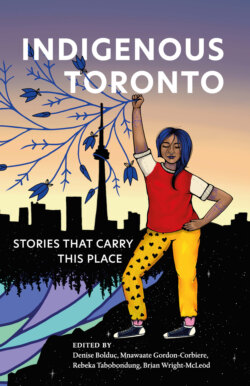Читать книгу Indigenous Toronto - Группа авторов - Страница 27
На сайте Литреса книга снята с продажи.
THE HISTORY OF THE LAND
ОглавлениеThe beginning of the mural depicts an Eagle Dancer representing the ancient Ice Runners, also known as the ‘Oh-kwa-ming-i-nini-wug’ of Algonquin lineage, who were here in those early days looking toward the future. The Return of the Buffalo is represented here and is part of the story of this land, as there were once giant wood buffalo that roamed across this territory now called the City of Toronto.
The second Ice Runner is the man running behind the wolf, who is the First Brother of Man. The Black Thunderbird symbol in the Medicine Wheel Circle is the symbol of the Anishinaabeg nation, the first to inhabit this territory.
Then you will see the Tobacco Plant, an important sacred medicine offered up in our ceremonies. Tobacco is in the East on the Medicine Wheel. It is one of the four sacred medicines.
The Crane is part of the Anishinaabe clan system and governance. The Crane Clan shares power of Chieftainship with the Loon Clan. It takes care of the leadership of external relations, external negotiations, speaker of the community, leadership, and mediation, and expresses sentiments for the people, but the wishes of the group.
The next symbol, the Beaver, represents the Wendat people, the next in the order of inhabiting this territory.
Next you will see an Anishinaabe Moccasin, a message of the many trails Indigenous peoples travelled across the city over 13,500 years ago. The Moccasin is on Cedar, a medicine that is put down on the arbour of the Sundance. Cedar, in the South on the Medicine Wheel, is most often used as a tea and for bathing and cleansing in Cedar Baths.
The next symbol is the Star Symbol of the Cree peoples, who next came to the land to live here.
Then the mural depicts the Eagle, which can travel between the physical world and the spiritual world, and is thus closest to the Creator.
The eagle feather and eagle wings are sacred. They are used in Smudge Ceremonies, and the eagle feather is a symbol of truth, power, and freedom.
The Beaver is a symbol of advancement and industry/progress, since he is a builder.
Next is the Canoe and Sage. Sage, in the West on the Medicine Wheel, is another medicine used for smudging and cleansing. The Canoe is a symbol of all the paths the Indigenous people created that are still used to this day, like the Humber River trail, the Don River, etc.
The next Circle is the flag of the Haudenosaunee people. It represents the Hiawatha wampum belt.
Beside the Circle, we have the Raven (also known as the Trickster) and the Bear.
The Fish, a knowledge keeper, represents the intellect of the community.
The Bear is another Clan animal. Bears are settlement guardians: they patrol the local area. They also know medicinal plants and are healers, guardians of traditions. The Bear stands on a loop of braided Sweetgrass. This medicine is in the North, another one of the four sacred medicines used in smudging and ceremony. Sweetgrass is a symbol our Mother Earth’s hair. We braid sweetgrass to show our respect for her and all she does for us every day.
The History of the Land, Philip Cote, acrylic and latex on brick wall, 65′ × 9′, 2017. Location: Spadina and Dupont, northeast corner. (The mural was commissioned by Dupont by the Castle BIA and the City of Toronto.)
The Bear looks on toward the Giant Buffalo. There were once 60 million Buffalo in North America, only to be slaughtered by the settlers so they could take the land from the Indigenous peoples. The Buffalo was vital for the survival of Indigenous peoples of North America, who used all the parts of the animal: the furs for clothing and warmth, the meat for food, and the bones for tools. Nothing was wasted. Buffalo was a major food source and taken away due to the murder of the Buffalo by the colonists.
It is said that one day there will be a Return of the Buffalo to this land and territory, so they can roam free as they once did here. This is what we all look forward to.
‘Nindinawemaaganidok’ – ‘All My Relations,’ which means ‘We Are All Related.’
